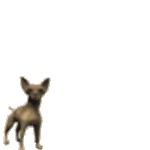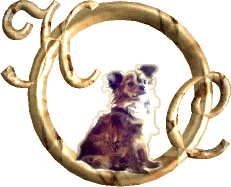 |




Chihuahua Facts!!
and other Information

General Appearance
A graceful, swift-moving, alert little dog with a sausy expression, compact, and with terrier-like gualities of temperment.
Size, Proportion, Substance
Weight: A well balanced little dog not to exceed (6) six pounds.
Proportion: The body is 0ff-square; hence, slightly longer to the point of buttocks than the height at the withers. Somewhat shorter bodies are preferred in males.
Disgualification: Any dog over (6) six pounds in weight. Broken down or cropped ears. Cropped tail, bobtail, and in a long coat, too thin of a coat that resembles bareness.

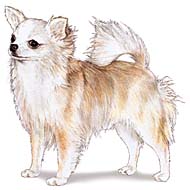
Head: A well rounded "apple dome" skull, with or without molera.

Eyes: Full, but not protruding, balanced, set well apart-luminous dark or liminous ruby. (Light eyes in blond or white colored dogs permissible.)
Ears: Large, errect type ears, held more upright when elert, but flaring to the sides at a 45 degree angle when in respse, giving breadth between the ears.
Muzzle: Moderately short, slightly pointed. Cheeks and jaws lean.
Nose: Self colored in blond types, or in black. In moles, blues, and chocolates, they are self colored. In blond types, pink nose permissable.
Bite: Level or scissors. Overshot or undershot bite, or any distornion of the bite or jaw, should be penilized as a serious fault.
Here a couple of books I highly recommend!
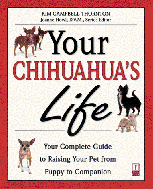



The American Kennel Club Goals Of The AKC
The American Kennel Club, or the AKC, was established in 1884 "to promote the study, breeding, exhibiting and advancement of purebred dogs." Today, it's the nation's leading purebred dog authority. The organization holds a number of significant events such as dog shows and competitions, handles all purebred pedigree paperwork and dog registrations, as well as establishing breed standards. Mission Statement
The AKC's Mission Statement is to: Maintain a registry for purebred dogs and preserve its integrity. Sanction dog events that promote interest in, and sustain the process of, breeding for type and function of purebred dogs. Take whatever actions necessary to protect and assure the continuation of the sport of purebred dogs.
AKC Specs The AKC is the largest non-profit dog registry in the nation. Dog owners reister more than 1.3 million dogs in the 140 eligible breeds each year. In addition, more than 1.9 million dogs participate in over 15,000 AKC events.
Canine Legislation The AKC's Canine Legislation Department monitors and governs the following issues: resolutions endosrsing responsible dog ownership; hunting; animal welfare and cruelty; dangerous dog control; animal enterprise and animal exhibition protection; assistance and service dogs; dog licensing; pet population issues; kennel, gromming and pet shop regulations; consumer protection for dog buyers; animal shelters; veterinary topics; nuisance; transportation of animals. The AKC takes an active governmental role in these issues. AKC Papers When purchasing a purebred dog from a breeder, he or she will almost always be accompanied by paperwork which allows you to register your dog with the AKC. Registering your purebred with the AKC allows you to participate in a number of AKC-sponsored events, including all dog shows, etc. In addition, the registration certificate you will receive is essentially a certificate of your dog's identity. It includes official documentation of your dog's pedigree, it's family tree.
Dog Nutrition
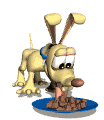
Contact Your Vet The best advice anyone can give concerning your dog's diet is to contact your veterinarian. Each breed, as well as each individual dog, has its own special requirements. Avoid Table Scraps Most importantly, avoid constantly feeding your dog table scraps. Not only are they an extremely unbalanced diet, but they can lead to overweight dogs. This is especially true in toy breeds. A small amount of food goes a looooong way! Also, it's very important to be careful with foods which are poison to dogs, such as chocolate, for example. So much as a bite of chocolate can kill a small dog. Avoid Variety Dogs do not need a variety in their diet. In fact, their body systems are much better off with just one brand of food. If you wish to change your dog's diet, make sure to do so very gradually.
Bad Breath and Dental Care Bad breath, created from food, tartar deposits, or digestive problems, is a common problem with dogs. Feed your dog dry food and tartar-fighting treats to help reduce plaque. In addition, it is highly recommended that you buy a small doggie toothbrush and toothpaste and brush your pup's teeth about once a week. (However, never use human toothpaste). Aside from cleaning the teeth, brushing will establish a closer bond between you and your pet. Be sure to also bring your dog to frequent trips to the vet to have his or her teeth cleaned. Gingivitis is a huge problem in small dogs and often leads to the necessity to have the teeth pulled. Water And Baking Soda Go A Long Way Many light-colored breeds such as the Maltese get what is called tear staining... ducts by the eyes shed a reddish substance which gets into all the fur or hair around the muzzle. While this happens with breeds such as the Yorkie, as well, it is not as pronounced as in light breeds such as the Maltese or Poodle. The tear staining can be removed as following: in a small bowl, mix some baking soda with water until it is at a pasty consistency. With a toothbrush, brush the mixture into the dog's muzzle. The red staining should come right out. Interestingly enough, the tear staining is due to red dye in the foods which your dog eats. Many commercial brands, especially Eukanuba, contain red dye although they don't say so on the packaging.
General Dietary Tips It is unhealthy for a dog to be overweight. If you think your dog needs to lose a few pounds,m slowly cut down its calorie intake. An irregular eating schedule can affect your dog's digestive system and ultimately cause digestive problems. Your dog should receive only one or two meals daily, at a constant time. Be careful when changing your dog's feeding schedule... expecting food at a certain time is a conditioned behavior. Make sure that your dog's food and water bowls are kept in the same place every day, and don't leave the food out longer than about 30 mins. If your dog walks away for a long time, he probably isn't hungry anymore and won't come back.
Tips for Traveling

Safety When traveling, unless your puppy is very comfortable and well-trained, a crate should be used. Be sure to provide plenty of water and a favorite toy. In addition, be sure the crate: is large enough to allow the dog to stand, turn, and lie down; is strong; has a leak-proff bottom; has ventilation; has a "LIVE ANIMAL" label with owner's contact info. By Car Be sure to keep your dog comfortable when traveling by car. If it's hot, open windows to provide ventilation

However, do not let your dog stick its head out the window! IN addition, do not let your dog travel in the back of an open pickup truck or in the front seat where he or she could be a distraction to the driver. To help prevent motion sickness, take several short trips in the car befor eyour journey. Also, feed your dog lightly before the trip. By Plane When traveling by plane, visit your vet before the trip as a certification of health must be provided no more than 10 days before travel. Each airline has its own variations on regulations and services for pet transportation. When making your reservations, you must make reservations for your dog, as well. If your dog is crated and under ten pounds, some airlines allow the pup to stay with you underneath your seat rather than with cargo. Lodging If you plan to stay at a hotel or motel, be sure to find out advance if dogs are allowed. Be sure, however, to never leave your dog unattended in a strange place ... especially if he or she is prone to separation anxiety. Traveling Internationally International travel can be very tricky, as each country has its own rules and regulations. However, many countries have a quarantine period for all pets entering their country. The United Kingdom, for example, quarantines dogs for six months! If it could at all be avoided, please do not bring your pets overseas. Other Helpful Tips make sure your dog has a sturdy leash and collar carry recent pictures of your dog with you in case of separation take your vet's phone number and any special medication bring your dog's vaccination records.
Weather Tips
Winter Health Tips Don't leave your dog outside for long periods of time. Keep your dog warm, dry, and away from drafts. Be extra careful when near frozen water. Groom your dog regularly to keep him properly insulated. Feed your dog add'l calories if he is a working dog. Towel or blow-dry a wet dog. Don't leave your dog alone in a car. Antifreeze is poisonous to dogs although they like the smell. Rock salt to melt ice may irritate footpads. Provide plenty of fresh water. Don't allow your dog to get frostbite. Be careful of fireplaces which can burn your dog. Summer Health Tips Have your dog's vaccinations updated. Beware of insect bites. Talk with your vet about flea and tick prevention. Take your dog to a vet for a heartworm check. Most lawn and garden products are poisonous to your pets. Dogs may need extra bathing when constantly outdoors. Never leave your dog unattended in direct sunlight or a car. Make sure your dog has constant access to fresh water. Make sure your dog is always wearing identification. Keep your dog on a leash outdoors. Avoid strenuous exercise on extremely hot days.
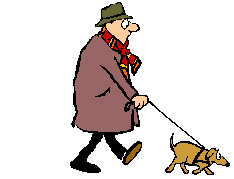
Good Breeder

Are You A Responsible Breeder? Responsible breeders... believe that each new litter should represent an improvement. are aware that each breed has an official standard and breed dogs who meet this standard. give careful consideration to health issues. know that every dog has flaws and breed to complement or eliminate them. plan ahead and place puppies in good homes. accept responsibility for the puppies they produce.
Holiday Hasards!

This information is not meant to be a substitute for veterinary care.
Always follow the instructions provided by your veterinarian.
The holiday season brings excitement and commotion associated with shopping, final exams, travel, and other seasonal preparations. In all the activities of the season our beloved pets may be exposed to hazards less commonly found other times of the year. As homes fill with holiday spirit, pets may be intrigued by the new sites, smells and tastes. The following are some of the most common health concerns for your pet during the holidays. If you have specific questions regarding any pet health concern please contact your veterinarian.
Curious pets may eat just about anything
Tinsel, Ribbon and other Pretty Things
Ribbons, wrapping paper, ornaments, tinsel, extension cords and gifts may be appealing "chew toys" that may make your pet sick.
There is something about those shiny strands of Christmas tree décor, which drives kitties wild. Although the sight of your cat pawing at the tree may be cute, the ingestion of tinsel can be deadly. Eating tinsel or other string-like items such as ribbon (often called linear foreign bodies) can cause serious damage to the intestine. One end can get stuck while the rest is pulled into the intestine as it contracts; the contractions may cause the ribbon or tinsel to saw through the intestine. If not caught in time, infection of the belly cavity develops and the prognosis for recovery becomes poor. Pets with linear foreign bodies quickly become ill with signs including vomiting, diarrhea, depression, belly pain and sometimes fever.
Eating other holiday decorations can cause signs ranging from mild depression to severe vomiting or diarrhea, depending upon whether or not the foreign matter can be passed in the stool or gets stuck along the way. Foreign matter stuck in the intestine often does NOT show up on "x-ray" but sometimes the foreign matter will trap air in the intestine, which helps your veterinarian make a diagnosis. Surgery is required to remove foreign matter that does not pass out on its own.
Christmas lights can result in electrical burns or electrocution
Holiday Lights
Decorative lights are another attraction for pets to chew on. Both indoor and outdoor lights should be carefully examined to ensure safety for your household pets. Electrical shock may occur from defective cords as well as from pets chewing on cords. Check cords for any signs of bite marks, loose or frayed wires, proximity to the tree's water supply or evidence of short circuits. Use grounded "3-prong" extension cords and strictly follow manufacturer's guidelines for light usage.
Electrical shock can cause burns, difficulty breathing, abnormal heart rhythm, loss of consciousness, and death. Call a veterinarian immediately if your pet has been injured by electrical shock. Treatment will be most effective if begun soon after the shock.
Too much of a good thing...
Overindulgence
Well-intentioned family and friends may share holiday foods with pets causing the pet to develop a stomach upset or worse, pancreatitis (inflammation of the pancreas) which can be caused by eating fatty foods. To control excessive food intake by your pets and meet your guests' desires to feed the pets, dole out the treats your pets would normally receive and let your guests "treat" the pets. If you want to get festive, mix some of your pet's regular food with water to make a "dough" and roll out and cut into festive shapes, then bake until crunchy.
Extra attention from visiting relatives and friends may be relished by some pets while others seek solitude in their favorite hiding spot. Make sure pets are given some "personal space" if they want to get away from the commotion.
Some pets may respond to all the hullabaloo with a change in behavior including bad behaviors like eliminating in the house. Try to spend a little extra "quality time" with your pet to assure them they have not been forgotten.
Chocolate can be poisonous
Chocolate

What would the holidays be without boxes of chocolate and warm cocoa in front of the fire? However, chocolate can be toxic or even fatal to dogs and cats. Chocolate may be mistakenly given to pets as treats and may be irresistible to the curious canine. Chocolate poisoning occurs most frequently in dogs but other species are also susceptible. Theobromine is the toxic compound found in chocolate. Signs which may appear within 1 to 4 hours of eating chocolate include:
Vomiting
Increased thirst
Diarrhea
Weakness
Difficulty keeping balance
Hyperexcitability
Muscle spasms, seizures, coma
Death from abnormal heart rhythm
The toxicity of chocolate depends on the amount and type of chocolate ingested:
Source
|
Potential Toxic Dose (44lb dog)
|
Unsweetened Cocoa
|
3oz
|
Baking Chocolate
|
5oz
|
Semisweet Chocolate
|
7oz
|
Milk Chocolate
|
20oz
|
The amount of theobromine in white chocolate or chocolate flavored dog treats is usually negligible. As with any poisoning, call your veterinarian or an emergency veterinary hospital immediately if you suspect your pet may have ingested chocolate. Have the product label information available when you call your veterinarian. There are national and regional poison control hotlines for animals. In general, the treatment of poisonings is most effective if begun soon after eating the poison, before large amounts are absorbed into the blood.
Chocolate
Symptoms:: Vomiting, diarrhea, increased heart rate,
rapid breathing, muscle tremors, seizures and coma.
It ofNutmeg
Symptoms:: Hallucinogen.
ten surprises pet owners to discover that for animals, chocolate is
poisonous in sufficient dosages. Specifically it is the drugs in chocolate,
TheOnions ine
ine
 ine
ine and caffeine (of the drug class methylxanthines),
that are toxic to pets. Only a moderate amount needs to be eaten by an animal,
typically a dog, in order to be poisonous
(apprCause anemia.
Onions (Dangerous)
Onions, both raw and cooked, contain disulfide, a substance that, while
harmless to humans, can cause oxidative damage to the red blood cells
in cats, dogs, horses, sheep and cattle. Red blood cells contain hemoglobin,
which transports oxygen to the rest of an animal’s body.
The condition caused by consumption of onions is called Heinz body hemolytic anemia.
Toxic dose: As little as two slices of onion a week can damage red blood cells
sufficiently so that they cannot carry enough oxygen to meet the body’s needs.
Symptoms Of Onion Poisoning:
Weight loss
Lassitude
Excess panting
Depression
Rapid pulse
Weakness
Pale mucous membranes (gums and mouth)
Treatment: If you notice these symptoms, take your dog to the vet.
This is an urgent situation. Your dog may be fond of cooked onions,
although raw ones might be too pungent for her sensitive nose.
Since you can never be sure where the limits of your dog’s taste may lie,
keep her out of the garden if you are growing onions,
and make sure your garbage cans are secure.
Onions should not be fed to dogs in any form.
ox. 1/2 oz. of baking chocolate per pound of body
weight and less in some animals).
It is also believed that dark/plain chocolate is mo
Liver (Dangerous)
Liver is a favorite food for dogs. Many of the treats and prepared foods that you
give her contain liver. In small amounts, liver is great for your dog.
If her liver intake is too high, however, it can cause nutritional problems
because liver has a high content of vitamin A. Consumption of this vitamin
in large amounts can lead to vitamin A toxicity, or hypervitaminosis A.
Toxic dose: If your dog eats raw liver or consumes three servings of cooked
liver a week, she could be headed for bone problems.
Never feed her liver if she is also on vitamin A supplements.
Symptoms Of Hypervitaminosis A:
Deformed bones
Excessive bone growth on the elbows and spine
Weight loss
Anorexia
Treatment: If your dog is exhibiting any of these symptoms, take her to the vet.
If left unchecked, hypervitaminosis A has in some cases caused death.
Prevention: If you are feeding your dog both canned food and liver,
check the label for ingredients to make sure she isn’t getting a double dose of this treat.
Also, always cook liver; never feed it raw.
Bones (Dangerous To Deadly) 

The big, treated bones that you can buy your pet in a pet store are
of an entirely different composition from the bones in the meat you
buy at the grocery. Store-bought bones are specially treated so that
they will not splinter. If splinters break off, they can become lodged
in your dog’s throat or lacerate the insides of your dog’s mouth,
esophagus, stomach or intestines. Cooked poultry bones are the
worst culprits for splintering, but any cooked, dry bone can be deadly.
Symptoms Of Choking:
If your dog is choking, she will show some or all of these signs:
Pale or blue gums
Gasping
Open-mouthed breathing
Pawing at face
Slow, shallow breathing
Unconscious, with dilated pupils
Treatment: This is a life-threatening situation.
Try to remove the obstruction and rush to a vet.
Splintered bones: It may be hard to tell if a bone has splintered.
If it lodges in the mouth or high in the throat, you or your vet may
be able to remove it. If it splinters in the stomach or intestine,
the only symptoms may be severe pain and death.
Prevention: You can treat bones yourself by cooking them until they are soft.
This can be done quickly in a pressure cooker.
The marrow is a good source of calcium, phosphorous and copper.
Chewing on bones also helps remove plaque from the teeth.
Seal off your garbage can to ensure that your dog doesn’t prowl through
the refuse for tidbits. Not only is this dangerous because of possible
choking and suffocation, but also there may be other hazardous items inside,
such as broken glass and discarded cleaning bottles
DRaw Eggs (Dangerous)
a n
n
 n
nAlthough athletes seem constantly to be consuming raw eggs
in one variety or another, think twice before giving your pet raw eggs.
Although cooked eggs are high in protein and make an excellent treat,
raw egg whites contain a protein called avidin,
which can deplete your dog of biotin, one of the B vitamins.
Biotin is essential to your dog’s growth and coat health.
Additionally, raw eggs are often contaminated with bacteria,
such as salmonella, and you could end up giving your dog food poisoning
in addition to biotin deficiency.
Symptoms Of Biotin Depletion:
Hair loss
Weakness
Growth retardation
Skeleton deformity
Treatment: If your dog is suffering from these symptoms the situation is urgent,
and she should be taken to the vet.
Prevention: Eggs, when cooked, are an excellent treat for your dog.
They are high in protein and essential nutrients.
It is only the raw white of the egg that contains avidin.
You could feed her just the raw egg yolk, which does not
contain avidin, but you would still be risking bacterial food poisoning.
Salmonella:
Salmonella is a gastrointestinal infection. The bacteria enter the stomach,
surviving the acids inside to colonize your dog’s small intestine and lymph nodes.
From there, they can spread into the blood stream.
Once your dog is infected, she can transmit the disease to other dogs,
children and adults with impaired immune systems. Keep this in mind,
and keep your pet in a secluded area for the duration of her illness.
Symptoms Of Salmonella Poisoning:
Poor appetite
High fever
Diarrhea
Dehydration
Abdominal pain
Depression
Lack of energy
Treatment: If left untreated, salmonella infection can result in death.
This is a life-threatening situation, and your pet should be rushed to the vet.
Clostridium:
These bacteria give off a toxin that affects your pet’s nervous system.
If your dog contracts clostridium poisoning, she may need nursing
care for up to three weeks.
Symptoms of Clostridium Poisoning:
Vomiting
Stomach pain
Diarrhea, bloody in severe cases
Shock
Paralysis
Treatment: This is an emergency situation.
Rush your pet to the vet.
Prevention: Making sure that your garbage cans are secure and cooking meat
until it reaches the proper temperature can prevent both kinds of food poisoning.
Pork (Disagreeable) 

The fat globules in pork are larger than the fat globules in other meats.
Thus, they can clog the small blood vessels of a dog.
Avoid pork products, especially bacon, which also contains sodium nitrate.
Milk (Disagreeable)

If your pet has been eating ice cream and yogurt and has never had any problems,
you have a lucky pet. Many dogs are lactose intolerant
-- unable to produce the enzyme lactase --
so they cannot break down the lactose, or milk sugar, in dairy products.
Milk just does not agree with them.
If your dog drinks milk and you observe symptoms such as excess gas,
diarrhea, dehydration or skin irritation, you should determine if she is lactose intolerant.
Removing milk from her diet should cause all her symptoms to disappear.
To avoid or correct the problem, you can purchase lactose-free brands of milk products
specially formulated for dogs.
Lactose-free milk for humans can also work, although the nutritional balance
is not quite as good. Canned milk or sweetened, condensed milk is usually tolerable,
even to a lactose intolerant dog, and can make a good
substitute for the occasional must-have treat.
Mushrooms (Disagreeable To Deadly) 

Although store-bought mushrooms are perfectly safe for your dog to eat,
it isn’t a particularly good idea to have her develop a taste for them.
If she has free run of the backyard or is allowed to roam off leash in a park or field,
a taste for mushrooms can be dangerous.
Dogs with a mushroom fixation will be on the lookout for these treats.
If they sniff out some poisonous mushrooms and eat them,
the effects can range from disagreeable to deadly
Poisoning Things To Be Aware of!!!
In assessing the risk to your dog from these plants, you need to consider both
the age of your dog and it's propensity to chew on plants.
Many of the below toxic plants rarely cause problems because
most dogs don't chew them -- the exceptions being, of course,
young puppies who are inclined to explore the world with their mouths,
teething dogs who may chew on everything, and older dogs that are simply
fond of chewing. Oleander, for example, is rather toxic,
but most cases of poisoning involve
1) cattle, other grazing livestock
2) puppies
3) human babies/toddlers.
Dumb cane is probably the one plant that should always be kept out of reach,
since it takes only one nibble to have a potentially fatal situation.
That give rash after contact with the skin or mouth: (mums might produce dermatitis)
chrysanthemum
|
poinsettia
|
creeping fig
|
weeping fig
|
spider mum
|
pot mum
|
Irritating (toxic oxalates), especially the mouth gets swollen;
tongue pain; sore lips; some swell so quickly a tracheotomy is needed before asphyxiation:
arrowhead vine
|
majesty
|
boston ivy
|
neththytis ivy
|
colodium
|
pathos
|
emerald duke
|
red princess
|
heart leaf (philodendron)
|
split leaf (philodendron)
|
saddle leaf (philodendron)
|
marble queen
|
Toxic plants - may contain wide variety of poisons. Most cause vomiting, abdominal pain,
cramps. Some cause tremors, heart and respiratory and/or kidney problems,
which are difficult for owner to interpret:
amaryllis
|
elephant ears
|
pot mum
|
asparagus fern
|
glocal ivy
|
ripple ivy
|
azalea
|
heart ivy
|
spider mum
|
bird of paradise
|
ivy
|
sprangeri fern
|
creeping charlie
|
jerusalem cherry
|
umbrella plant
|
crown of thorns
|
needlepoint ivy
|
Here are more miscellaneous plants that we found on other lists.
The reactions to these plants are unknown, but they are considered dangerous
and should be avoided.
Monkshod
|
Andromeda
|
English Ivy
|
Apple seeds (cyanide)
|
Elderberry
|
Narcissus (bulb)
|
Arrowgrass
|
Avocado
|
Oleander
|
Hyacinth (bulb)
|
Boxwood
|
Hydrangea
|
Poison Ivy
|
Iris (bulb)
|
Cladium
|
Japanese Yew
|
Rhododendron
|
Jasmine (berries)
|
Rhubarb
|
Cherry Pits (cyanide)
|
Snow on the Mountain
|
Chokecherry
|
Stinging Nettle
|
Climbing Lilly
|
Laburnum
|
Toadstool
|
Tobacco
|
Laurel
|
Tulip (bulb)
|
Daphne
|
Walnut
|
Marigold
|
Wisteria
|
Dieffenbachia
|
Yes
|
Mistletoe
|
Common Outdoor Plants Poisonous to Dogs
(from Carlson & Giffin.)
Produce vomiting and diarrhea in some cases:
delphinium
|
poke weed
|
indian tobacco
|
daffodil
|
bittersweet woody
|
wisteria
|
castor bean
|
ground cherry
|
soap berry
|
indian turnip
|
fox glove
|
skunk cabbage
|
larkspur
|
May produce vomiting, abdominal pain, and in some cases diarrhea
horse chestnut buckeye
|
western yew
|
apricot, almond
|
rain tree monkey pod
|
english holly
|
peach, cherry
|
privet
|
wild cherry
|
mock orange
|
japanese plum
|
american yew
|
bird of paradise
|
balsam pear
|
english yew
|
black locust
|
Varied toxic effect
rhubarb
|
buttercup
|
moonseed
|
spinach
|
nightshade
|
may apple
|
sunburned potatoes
|
poison hemlock
|
dutchman's breeches
|
tomato vine
|
jimson weed
|
mescal bean
|
loco weed
|
pig weed
|
angel's trumpet
|
lupine
|
water hemlock
|
jasmine
|
dologeton
|
mushrooms
|
matrimony vine
|
dumb cane
|
Hallucinogens
marijuana
|
periwinkle
|
morning glory
|
peyote
|
nutmeg
|
loco weed
|
Convulsions
china berry
|
nux vomica
|
coriaria
|
water hemlock
|
moon weed
|
Poisonous Household Items
Acetaminophen
|
Laxatives
|
AntiFreeze
|
Lead
|
Aspirin
|
Lye
|
Bleach
|
Matches
|
Boric Acid
|
Metal Polish
|
Brake Fluid
|
Mineral Spirits
|
Carbon Monoxide
|
Mothballs
|
Carbuerator Cleaner
|
Nail Polish and Remover
|
Christmas Tinsel
|
Paint & Remover
|
Cleaning Fluid
|
Perm Solutions
|
Deoderants/Deoderizers
|
Phenol
|
Detergents
|
Photo Developer
|
Disinfectants
|
Rat Poison
|
Drain Cleaner
|
Rubbing Alcohol
|
Dye
|
Shoe Polish
|
Fungicides
|
Sleeping Pills
|
Furniture Polish
|
Soaps
|
Gasoline
|
Suntan Lotions
|
Hair Colorings
|
Tar
|
Herbicides
|
Turpentine
|
Insecticides
|
Windshield Fluid
|
Kerosene
|
Woodstains
|
Lawn Alert
Is your backyard a safe haven or a health hazard? Lawn chemicals, fences and mowers all spell danger for dogs.
Your backyard, with its colorful burst of flowers, chirping birds and sunny disposition, may seem like a perfect springtime retreat. But it can be a big, bad world to your pet. Everything from lawn chemicals to the fence around your private sanctuary can be dangerous to your dog.
So what's a pet owner to do? Obviously, keeping your dog cooped up inside isn't the answer. But taking a few precautions will let you both enjoy the great outdoors safely.
"Owning a dog is like having a 3-year-old," "You don't throw out Tylenol® because of children. You store it safely. It's the same with a dog in your yard."
Danger Ahead
Whether your yard is the envy or the laughingstock of the neighborhood, it has hidden dangers. For example:
•Chemicals. If used properly, most chemicals pose little risk. An exception is 2,4-D. The diethylamine salt in this weed killer can cause serious health problems in dogs. (Agent Orange used in Vietnam contained 50 percent 2, 4-D.) Rodent and insect repellents also are problematic, usually because people forget they've applied them.
Plants.
The list of plants toxic to dogs includes yew, rhododendron and tulip and daffodil bulbs. Check with a nursery if you're wondering about your plants. If you do indeed have the plants above, remove them or prevent access to them.
Equipment.
Moving objects are enticing to dogs, which is why lawn mowers, weed trimmers, chain saws and similar equipment are off limits. Keep dogs away from hot barbecue grills, too. (They love those meaty smells!)
Fences.
Although they provide a barrier to the outside world, collars can get hooked in sharp-edged chain-link fences, and wooden fences can give splinters. A break-away collar would be the answer here. Unless fences are tall, some dogs can jump over them.
Play It Safe
Creating a safe haven isn't as hard as you might think. View your yard through your dog's eyes. Is he a digger? Add pavers at the base of your fence. Does he like to chew? A chew toy will keep him from plants.
|
Winter Hazards
As winter approaches, many people will "winterize" their automobiles, including a change of antifreeze. Take care to keep both new and used antifreeze in a sealed container, out of reach of pets. Clean up any spills of antifreeze on driveways and other hard surfaces. Dogs and cats find antifreeze quite tasty and if they find antifreeze they'll drink it. Antifreeze is extremely toxic causing kidney failure that is often fatal in just a few days.
Very small amounts of antifreeze can be fatal. If a cat walks through a puddle of antifreeze and then licks its paws, it can ingest enough antifreeze to cause death. About five tablespoons can kill a medium sized dog. If you see your pet drinking antifreeze, or are at all suspicious that your pet may have had access to antifreeze, contact a veterinarian immediately.
Very small amounts of antifreeze can be fatal Signs of antifreeze poisoning depend upon the time after ingestion. In the first few hours after ingestion the pet may be depressed and staggering and may have seizures. They may drink lots of water, urinate large amounts and vomit. The pet may appear to feel better but in a day or two get much worse as the kidneys fail. Signs of kidney failure include depression and vomiting. The amount of urine they pass will often decrease to a very small amount.
The diagnosis of antifreeze poisoning is made by blood and urine tests although some of these tests become negative by the time kidney failure develops. Antifreeze poisoning should be considered in any free-roaming dog or cat with consistent signs.
Treatment must be started very soon after drinking antifreeze Treatment for antifreeze poisoning needs to be started as soon after ingestion as possible to be effective. The earlier treatment is started, the greater the chance of survival. Once kidney failure develops, most animals will die.
The treatment for antifreeze poisoning depends on when the pet is presented to the veterinarian. If the pet is seen within a few hours of ingesting antifreeze, vomiting is induced to remove any antifreeze still in the stomach and charcoal is placed in the stomach to bind antifreeze in the intestine. Antifreeze itself is not very toxic but it is broken down by the liver to other components that cause the damage. If the pet is presented to a veterinarian soon after drinking antifreeze, a drug is given that impairs the liver from converting antifreeze to these toxic products, allowing the unconverted antifreeze to pass in the urine. These drugs are useful only when given early and are not effective after the pet is already showing signs of kidney damage.
Animals who present to a veterinarian in kidney failure due to antifreeze poisoning can occasionally be saved with aggressive treatment. Some specialty veterinary practices offer dialysis which can be used to remove waste products that are not being removed by the diseased kidneys in an effort to keep the pet alive to give the kidneys a chance to repair. Whether the kidneys will repair themselves or not depends on how severely they are injured. Unfortunately the kidney damage caused by antifreeze is usually very severe and irreversible. Kidney transplantation has been performed in dogs and cats. There are several sites on the internet that describe transplantation.
Antifreeze Poisoning
Antifreeze or ethylene glycol (EG) is a commonly available coolant for
most water cooled engines. The availability of the product is slightly
seasonal in colder climates. However, EG is used year round as an
antifreeze and summer coolant. Unfortunately, the chemical is very toxic
and lethal in small amounts to all animals. Dogs and cats are probably
more susceptible because of their inherent nature to taste everything. In
particular dogs seem quite willing to try anything if smells or tastes
reasonable. EG is somewhat sweet to the taste. Newer coolants are now
available that eliminate the desirable taste but, EG is the predominant
coolant on the market.
EG is readily absorbed by the gastrointestinal system. Doses of less than
1ml per kg. in the cat and 4-5ml per kg. in the dog are fatal if not
promptly treated. The drug itself is not toxic but, the metabolites of EG
cause tremendous changes in acid-base balance and produce direct toxic
effects to the kidneys. In addition, EG metabolic byproducts cause,
metabolic acidosis, respiratory depression and upset glucose metabolism.
By the time most animals are presented with signs of EG toxicity it is
often too late to effectively intervene. The prognosis is hourly
dependent on the interval between ingestion and treatment. Most dogs will
recover if presented in the first 8 hours and within 4 hour for cats.
Early signs include vomiting in the first few hours with in coordination
problems. These signs may actually decrease significantly after 12 hours
but, by then the outcome is almost always certain and death will follow
in 2-3 days. After one day, most dogs will begin to show severe signs of
dehydration from vomiting and increased urination. Signs in the final
48-72 hours are mostly neurological including, incoordination,
depression, coma and death.
Therapy for EG poisoning is only effective if employed quickly, ideally
upon ingestion but no later than 24 hours. Early diagnosis is critical
for effective therapy and involves measuring serum osmolality which is
greatly increased in EG toxicity or by employing a commercial test for
serum EG. If consumption of EG ocurred within 6 hours, induced vomiting,
stomach pumping and stomach installation of charcoal adsorbants can be
effective. However, prevention of absorption of EG is best done within
the first two hours post ingestion. After EG absorption, stopping
metabolism of the drug involves preventing the action of the liver enzyme
alcohol dehydrogenase (ADH). Traditionally, intravenous administration of
20% ethanol has been employed in conjunction with bicarbonate and
steroids to counter acid base problems and shock. Ethanol has been
effective if treatment is given in the first hours after ingestion of EG.
The doses of ethanol employed to tie up ADH must be repeated every 4-6
hours over 2 days. Recomended doses of 5 ml/kg. cause severe depression,
occasionally coma, interfere with clinical assessment and increase the
difficulty of patient management.
Currently, a newer drug, 4-methylprazole (4-MP) has proven more effective
at blocking the action of ADH without the depressive side affects of
ethanol. If administered early, under 3 hours, nearly all of the EG will
be eliminated by the kidneys in the original unmetabolized form. This
drug has been shown to be very effective up to 8 hours after ingestion
and will provide some benefits even with intervals up to 36 hours. The
longer the interval between ingestion and treatment the greater the
amount of kidney damage. Unfortunately, 4-MP does not seem to be
effective in the cat.
Additional support during therapy includes traditional intravenous fluid
therapy and acid-base regulation if required. Convalescent therapy may
include low protein diets to rest the kidneys depending on the damage
incurred.
My dog is going to go under Anestheia
This information is not meant to be a substitute for veterinary care.
Always follow the instructions provided by your veterinarian.
Before the anesthetic procedure
A thorough history of current and past medical problems can provide valuable information about your pet’s physical condition. A history of poor ability to exercise may indicate abnormal heart or lung function, an important consideration when planning an anesthetic procedure. Physical examination may reveal abnormalities of the heart or lungs that may require further evaluation such as an electrocardiogram (ECG), chest x-rays, or heart ultrasound prior to performing general anesthesia. Many anesthetic drugs affect blood flow to major organs and are inactivated by the liver. Your veterinarian may evaluate a blood sample for anemia and for kidney and liver function prior to deciding which anesthetic technique to use.
There are many types of anesthetic regimes including the use of drugs that are injected into a vein or muscle or inhalant drugs that are breathed in and out of the body. Your veterinarian will select the anesthetic regime based on the health of your pet and on the type of surgical procedure to be performed. Tranquilizers are often given before a general anestheia
Pre-Anesthetic Evaluation
Many anesthetic techniques involve the administration of a sedative or tranquilizer before the anesthetic agent is given. Tranquilizers and sedatives can allow for less of the general anesthetic to be used. pre-anesthetic sedation may calm a pet excited by unfamiliar surroundings. Excited animals may require higher doses of general anesthetics and excitement may predispose to development of an irregular heart rhythm (cardiac arrhythmia). pre-anesthetic sedation may also make recovery from anesthesia smoother.
After pre-anesthetic sedation, an intravenous (IV) catheter is placed into a vein in either a front or hind limb, or occasionally in the neck. An IV catheter is the patient's lifeline while (s)he is under the effects of general anesthesia. Through the IV catheter your veterinarian will have ready access to your pet’s blood stream to administer fluids and other drugs during surgery. To prevent life threatening bacterial infections, it is important that the skin overlying the catheter site be clipped of fur and scrubbed with a surgical disinfectant.
General anesthesia is often begun by giving a short-acting anesthetic agent IV. As soon as the pet loses consciousness, a soft plastic tube (endotracheal tube or ET tube) is inserted into the windpipe and is connected to an anesthesia machine. The anesthesia machine is used to deliver an inhalant anesthetic in oxygen and other gases. Many anesthetic drugs can depress breathing; having an ET tube in place allows the veterinarian to assist or control breathing if it becomes necessary. The loss of consciousness that occurs during anesthesia is often accompanied by loss of the ability to cough and gag. In awake animals, coughing and gagging are protective reflexes which prevent inhaling stomach contents or other foreign materials into the lungs. Insertion of a proper size ET tube prevents inhalation of stomach contents into the airways and lungs during anesthesia.
At the completion of the surgical procedure, the concentration of the anesthetic that the animal is breathing is reduced and the animal slowly regains consciousness. When the pet regains its swallowing reflexes, the ET tube is removed and the patient is monitored until it is fully conscious.
. Monitoring General Anesthesia
There are several methods by which the pet’s response to anesthesia and surgery can be monitored during the procedure. Close monitoring during anesthesia allows for early recognition and correction of problems.
Vital signs such as heart rate, respiratory rate, and blood pressure can be monitored using specialized devices.
Rapid-acting, anesthetic drugs are easier to control if they are continuously administered. The anesthetic is “titrated” to achieve the desired level of anesthesia and analgesia. In other words, most general anesthetics are "dosed to effect".
The animal's depth of anesthesia is determined by evaluating reflexes, muscle tone, and response of vital signs to surgical stimulation. If an animal is judged to be too light for the surgical procedure being performed, an increased amount of anesthetic is administered. Conversely, if the patient is judged to be in an excessively deep plane of anesthesia, the amount of anesthetic administered is decreased.
Anesthetic Drugs
Modern day inhalant anesthetics are a tremendous improvement over older anesthetics. Inhalant agents are those that are breathed in and out rather than being injected into a blood vessel or muscle. While the newer anesthetics are "kinder" to an animal's organ systems, even the “safest” anesthetics are extremely potent and potentially lethal.
Newer anesthetics such as Isoflurane® are less likely to aggravate a pre-existing abnormal heart rhythm. Additionally, inhalation agents such as Isoflurane® enter and exit the brain rapidly, allowing for a rapid onset of and recovery from anesthesia.
Anesthetic Considerations
Some think of general anesthesia as a relaxing sleep. It is probably much more accurate to compare general anesthesia to a period of very strenuous exercise. Just as young, healthy animals are more able to exercise vigorously, they are more able to tolerate the depression in heart function caused by general anesthesia because they have such great cardiovascular reserve. Older or debilitated animals have less cardiovascular reserve and may have less tolerance for general anesthesia. Older or debilitated animals often recover from general anesthesia and surgery more slowly than a young patient, in part because of their decreased reserve.
Post-Anesthetic Considerations
After general anesthesia, animals are likely to be affected by the anesthetic drugs for several days.
An animal may exhibit behavioral changes for several days after general anesthesia. They may act as if they do not recognize familiar surroundings, people or other animals. Behavioral changes after general anesthesia are extremely common; fortunately they usually resolve within a few days. Do not leave young children unattended with an animal that has just recovered from general anesthesia no matter how trustworthy that animal normally is. Remember, your pet has been through a lot and probably won't fully recover and be himself/herself for several days. There are reports of normally well-behaved dogs returning home after surgery and anesthesia and biting young children for no apparent reason.
The pet’s ability to control its body temperature may be affected during the recovery period. Many anesthetics alter the temperature set point in the brain and cause blood vessels in the skin to dilate promoting heat loss. Conversely, an animal's natural cooling mechanisms may be unable to adequately respond to increases in environmental temperature. For the first few days after general anesthesia, it is recommended to keep your pet in a warm, though not overly hot room. Cold weather breeds such as Malamutes and Huskies tend to retain heat easily and a cooler environment may be more appropriate for these breeds.
Obese animals often have delayed recoveries. Most general anesthetics are very fat soluble so the greater the amount of body fat and the longer the animal is anesthetized, the greater amount of anesthetic agent that will be absorbed into body fat. Anesthetic taken up by body fat will leach back into an animal’s blood for days or even weeks after anesthesia. This low residual amount of anesthetic may continue to affect an animal's behavior for several days. Some breeds are more sensitive to certain anesthetics than other breeds.
Breed Sensitivities to General Anesthesia
Purebred dogs have been selectively bred to perform specific tasks such as retrieving or racing or have been bred to develop specific physical characteristics. Often, less desirable traits emerge as a result of selective breeding.
A common question posed to veterinarians is about the "sensitivity" of a particular breed of dog or cat to anesthetic drugs. This is a difficult question to answer, as there are few scientific studies that have evaluated the sensitivities of different breeds of animals to anesthetics. Many of the reported breed sensitivities are based on the clinical experience of veterinarians. Many giant breed dogs seem to require less of a pre-anesthetic sedative (a smaller dose per unit of body weight) than miniature or toy breeds. The reason for this apparent difference is unclear.
It has been documented that sight hound breeds of dogs are more sensitive to some of the ultra short-acting thiobarbiturate induction drugs. The administration of thiobarbiturates for induction of anesthesia in sight hound breeds has been associated with a slower recovery from anesthesia. The reason for this breed sensitivity is unclear at this time but may be related to a difference in liver metabolism of the drug and/or differences in body fat. When sight hound breeds are to be anesthetized, it has been recommended that non-thiobarbiturate induction drugs be used to prevent a prolonged recovery from anesthesia.
Within the same breed, individual animals respond to the same anesthetic in differing degrees. Vigilant monitoring of vital signs during general anesthesia will enable the veterinarian to recognize and respond to life-threatening changes in heart and lung function.
A patient who displays an abnormal response to any drug (anesthetic or not) should be monitored carefully if the situation dictates that the same drug be re-administered at a later date.
The Perfect Anesthetic Drug
The perfect anesthetic is a drug that produces no heart or lung depression, provides adequate analgesia, provides excellent muscle relaxation, is not metabolized by the patient, is not toxic, and is readily reversible. Although the general anesthetics in use in veterinary anesthesia today are great improvements compared to the anesthetics of yesteryear, they still fall far short of the perfect agent.
Probably, the most desirable general anesthetic for a young, healthy dog is the one your veterinarian is most familiar with. There are a great many anesthetic drugs available to today's practicing veterinarian, however most practitioners use a few carefully chosen anesthetics with which they have the most experience and the most confidence. Your veterinarian's experience in the use of a certain anesthetic drug often will more than offset one or two undesirable properties of a general anesthetic agent.
Preparing your Pet for General Anesthesia
There are several steps that a pet owner may take to help your veterinarian plan for a successful general anesthesia and surgery.
1. Communicate concerns about your pet’s health to your veterinarian prior to scheduling surgery. Any signs of exercise intolerance, weight loss, a recent change in urination or defecation, and mental alertness are particularly informative and may require further diagnostic workup.
2. Withhold all food from pets scheduled for elective surgery for at least 12 hours prior to arriving at your veterinarian's clinic. The presence of food in a pet's stomach will greatly increase the likelihood of aspiration of food into the lungs, should your pet vomit during induction of general anesthesia. Usually water is NOT with held but check with your veterinarian.
3. Balance your desire to keep your pet in show condition with the knowledge that the risk of infections increases greatly if the skin overlying the IV catheter site is not properly disinfected prior to IV catheter placement. Proper disinfect ion requires clipping of the fur overlying a suitable vein.
4. Follow your veterinarian's discharge instructions. If you have small children at home, be careful not to leave your dog alone with the small child even for just a few minutes. Remember, all animals recovering from all general anesthetics may react unpredictably for several days.
The Stages of Canine Reproduction
A Complex Process
By understanding the natural cycle,
you can have a better appreciation for the
miracle of canine life.
Reproduction is a complex event, and everything has to be just right for pregnancy to occur. By understanding this natural cycle, you can have a better appreciation for the miracle of canine life.
The Reproductive Stages
The reproductive cycle in dogs varies tremendously depending on breed and size of the animal. Puberty may occur as early as 6 months old in small breeds and as late as 2 years old in larger breeds. On average, you can assume that the first estrous cycle (heat cycle) will occur between 6 and 12 months of age. The duration of the estrous cycle in a particular dog is fairly consistent over time, but again, there’s a great deal of variability between breeds. Some breeds will cycle once every 4 months (e.g. German shepherd) while others will cycle once every 12 months (e.g. basenji). In general, older bitches (female dogs) cycle less frequently than those younger. The estrous cycle in the dog can be divided into four stages: proestrus, estrus, diestrus and anestrus.
Proestrus: Getting Ready
Proestrus is the time when a bitch's reproductive tract is preparing for the possibility of breeding with a male dog. It lasts an average of 9 to 11 days, but can last for as little as 3 or as long as 21 days. Its onset is usually accompanied by a bloody discharge from the vagina as well as swelling of the vulva. Identifying these signs depends on how much hair your dog has at her hind end and how thoroughly she grooms herself. A bitch may become attractive to male dogs during proestrus, but she’ll show little interest in the males at this stage. The walls of the bitch's reproductive tract thicken during proestrus and it’s possible to collect epithelial cells (cells from the uppermost layer of the skin) from the reproductive tract of the bitch with cotton swabs to determine approximately how far along she is in her cycle.
If the epithelial cells are viewed under a microscope, their size and shape will change as the estrous cycle progresses. In the previous stage of the estrous cycle, anestrus (see below), the epithelial cells of the reproductive tract are small and round with a darkly stained nucleus. As proestrus ensues, these cells become larger, more angular and have little staining of the nucleus, while dramatically increasing in number. Under a microscope, many red blood cells and some white blood cells, which were not present in the previous stage, can be seen in proestrus. Hormone levels also change during proestrus. Although estrogen levels rise in anestrus, they remain relatively low during the early part of proestrus. As the bitch enters the latter parts of proestrus, however, estrogen levels continue to rise, reaching their peak near the end of this stage. Estrogen begins to fall as another sex hormone, progesterone, begins to rise. Progesterone remains high throughout the next two stages of the heat cycle, and is one of the hormones that can be measured to indicate when a bitch is about to ovulate and, therefore, should be bred.
Estrus
Estrus is the next stage of the estrous cycle. It also lasts an average of 9 to 11 days, but can vary from 3 to 21 days. It can be defined as the time when the bitch accepts the male dog for breeding. During this stage, she sometimes exhibits a behavior called "flagging." This involves the bitch standing in one place, sometimes shuffling her feet, while at the same time, lifting her tail to allow the male to sniff her hind end.
During estrus, the vaginal discharge decreases, becoming less bloody in many dogs. None of the small round epithelial cells that were typical of early proestrus can be seen under a microscope in estrus. The progesterone level continues to rise. Near the onset of estrus, there is a very short rise in another sex hormone, luteinizing hormone (LH). Once this has peaked, ovulation usually occurs within 24 to 48 hours. The prime time to breed the dog is approximately 2 days after ovulation or 4 days after the LH surge.
Diestrus: A Delicate Time
The next stage of the heat cycle, diestrus, is considered the period when progesterone dominates the hormone scene. Diestrus lasts from 60 to 90 days in a dog that doesn’t become pregnant or approximately 63 days in a dog that does become pregnant. As a consequence of the bitch’s long exposure to progesterone when she’s not pregnant, she’s prone to a condition called pyometra if not spayed. Pyometra occurs when the uterus fills with bacteria and white blood cells. If untreated, pyometra can lead to fatal illness due to toxins secreted into the blood stream or the uterus actually rupturing. Thus, it’s highly recommended to spay a bitch that will not be used for breeding.
In diestrus, the vaginal discharge will cease and the epithelial cells of the reproductive tract quickly appear small and round again. White blood cells can be seen in very high numbers during the first few days of diestrus. This is normal since their function is to clean up the cellular debris left behind by estrus.
Anestrus: The Final Stage
The final stage of the heat cycle is called anestrus. Anestrus lasts an average of 4 to 5 months. It’s usually considered a time when the sex hormones are at very low levels, although they do continue to have small rises and declines throughout this stage. If a swab of the reproductive lining is taken and viewed under a microscope at this stage, very few epithelial cells can usually be seen. Those present will usually be small and round.
Normal Labor and Delivery in the Dog
Giving birth can be a frightening, confusing and painful experience for both the dog and the owner. Knowing and understanding normal labor and delivery, as well as proper pregnancy care, can help make the process go more smoothly and help you know what is normal and when it is time to get the veterinarian involved.
Gestation
In the bitch, a female dog, gestation lasts 63 days. Knowing the exact time of conception, however, is difficult since a bitch can be receptive to the male before and after ovulation. For this reason, the time from breeding to delivery is usually somewhere between 58 to 70 days. Your veterinarian can help narrow this time frame by examining the cells of the vaginal wall.
Be aware that just because your bitch bred does not mean she is pregnant. Some dogs will even show signs of pregnancy and not really be pregnant. There is a phenomenon in dogs known as false pregnancy or pseudocyesis. For confirmation of pregnancy, an examination, with ultrasound and possibly X-rays by your veterinarian, is suggested.
Nutrition
Once pregnancy is confirmed, proper care of the mother-to-be is very important. Before breeding, make sure she is up to date on all her vaccinations. It is not recommended to vaccinate your dog during pregnancy. Also, make sure she is dewormed and tests negative for a bacteria known as Brucella. This bacteria can cause abortion in dogs and is also contagious to people.
After breeding and conception, most bitches do well during the first 4 to 5 weeks of pregnancy and do not need any special treatments. Things start to change during the last trimester (week 5 to 6). The babies start to rapidly develop and this results in a significant nutritional drain on the mother. At this time, you may want to consider gradually changing her diet to a growth type diet or a food specifically made for pregnant or lactating bitches. Continue this diet throughout the remainder of pregnancy and until the puppies are weaned. Vitamins or other supplements are not recommended nor needed. With a proper diet, your dog will receive the proper amount of nutrients. Excessive amounts can actually result in birth defects.
Do not begin feeding your dog a higher calorie food before the last trimester. This can lead to weight gain and fat deposits. This has the potential to cause difficulty in maintaining the pregnancy and can result in problems delivering the puppies.
Preparing for Delivery
As the time of delivery approaches, you may want to make a whelping box to provide a safe and clean area for your dog to deliver. Whelping boxes are intended to be easily accessed by the mother but escape proof for the new arrivals. You can use wood, Formica or any building material that is easy to clean. Make the box large enough for the bitch to comfortably stretch out. Make sure the sides are just low enough for the mother to step over and place the box in a warm, dry, draft-free area. If possible, try to choose a quiet and secluded area. Initially, place newspapers on the bottom of the box for easy clean up. Once all the puppies are born, place blankets or towels to provide some footing for the puppies. Be aware that you must get the bitch used to the whelping box before the birth. If not, she may make her own decision on where to have the puppies – and this may be a closet, a pile of fresh clean laundry or even in the middle of your bed!
An additional suggestion is to have your dog examined by a veterinarian toward the end of pregnancy. A thorough physical exam, along with ultrasound or X-rays can help determine how many puppies you can expect. This way, you will know when she is done delivering and not just in another resting phase between pups.
Labor and Delivery
Stage 1
Temperature will drop to 98 degrees or so...
Eyes will dilate
She will stare at you and want you near
Refusal to eat
Hide under your bed or a dark place
Laying on her side but can't seem to get comfortable
Mucus Discharge
Stage 2 - pre labor
Digging
Shivering
Panting
Staring at her rear end
Licking vulva excessively
Mild Uterine Contractions
Stage 3 - Labor
Hard Uterine Contractions
Extreme Shivering
Water Breaking
Grunting and pushing
Visible sign of the First pup and delivery (Whelp)
Note # If the Dam is pushing and grunting and crying out in pain that lasts for over an hour
with no visible pup, you maybe in trouble.
As the time of delivery approaches, twice daily monitoring of the bitch’s body temperature will help alert you to the impending birth. About 24 hours before the beginning of labor, there will be a temporary drop in the body temperature. Normal temperature is 101 to 102.5 degrees Fahrenheit. Twenty-four hours prior to labor, the temperature can drop to 98 to 99 F.
Labor Stage I
After the temperature drop, stage I labor begins, characterized by restlessness and anxiety. You may notice panting, pacing, refusal of food and maybe vomiting. Nesting behavior begins. This is the time to place her in the whelping box (hopefully she is already accustomed to the box). After getting settled in the whelping box, you may notice her dragging clothing or fabric to the area to form a comfortable bed. You may want to remove any clothing as whelping begins or these pieces of clothing may be permanently stained.
This stage of labor typically lasts 6 to 12 hours. At the end of stage I, the cervix is completely dilated. If your dog has not started whelping within 24 hours after beginning stage I labor, veterinary assistance is recommended.
Labor Stage II
Stage II labor is defined as the part of labor when the puppy is delivered. Visible contractions begin. The abdomen tenses and the bitch begins straining. This action will appear similar to the bitch trying to have a bowel movement.
The first puppy should be delivered within 1 to 2 hours of the onset of contractions and straining. Veterinary assistance is strongly encouraged if the first puppy is not delivered within 2 hours after the onset of contractions.
After delivery of the puppy, the bitch may enter a resting phase that can last up to 4 hours. Active straining will begin again and more puppies will be delivered. If you know there are additional puppies yet to be born and the resting period is longer than 4 hours, veterinary assistance is necessary. This resting phase may not occur after each delivery. Sometimes, several puppies may be born rapidly.
Labor Stage III
After delivery of a puppy, the bitch may enter stage III labor. This is the time when the placenta, after birth, is delivered and usually occurs 5 to 15 minutes after delivery of the puppy. If multiple puppies are born rapidly, several placentas may be expelled together. After the passage of the placenta, the bitch will return to stage II labor. She may continue the resting phase or begin contracting. Throughout whelping, the bitch will fluctuate between stage II and stage III labor until all the puppies are born. It is very important to keep track of the number of placentas. There should be the same number of placentas as puppies. If a placenta is retained in the uterus, the bitch will eventually become quite ill.
Whelping
As soon as the puppy is born (whelped), the mother should immediately start cleaning the puppy. She should begin vigorously licking the puppy, remove him from the amniotic sac if still present and chew the umbilical cord. The bitch may even ingest the placenta. This is not necessary and, sometimes, can lead to vomiting and diarrhea. Prompt removal of the placentas can help you keep track of how many placentas she has passed.
Those puppies that are born still in the sack need immediate help. If the mother does not open the sack and begin cleaning the puppy, it is up to you to help. Tear the membrane of the sack and begin cleaning and rubbing the puppy with a clean dry towel. Cleaning other puppies may be necessary if the mother is not showing much interest in her newborns. Tie off the umbilical cord about 1 inch from the belly wall using string, thread or dental floss. Cut the cord off on the other side of the tie. Clean and rub the puppy vigorously until you hear crying. Place the puppy back with the new mom and make sure she allows the puppies to nurse.
Being prepared to assist and understanding newborn puppy care is essential to help the mother and her babies through these first steps of life.

